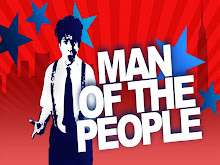In this turn, the talented Olivia Lehrmann tackles new territory with an ambitious solo cown piece.
The premise is clever: a cute, naïve personage works as a server in a restaurant for an unseen but heard fascist boss and fantasizes about being a secret agent. Sort of a “Secret Life of Walter Mitty” premise. He various fantasies give her the chance to show off her musical and acrobatic skills (Although I could've stood to see more working of acrobatics into the dramatic situation —she's got the chops, she might as well use them...)
Along the way, she gives a plastic ring to an audience member that she treats as a customer in her “restaurant”, then takes the ring back, loses it, pretends like the the audience member cares about her losing it, transforms herself into a secret agent in order to find the ring, interviews a few audience members she treats as customers in her imaginary restaurant that she imagines now are some kind of other secret agents, gets yelled at by her imaginary boss, who she sometimes pretends she imaignes to be to be a secret agent, too, and finally finds the plastic ring taped to a plunger she has placed backstage that she makes an audience member pretend to find.
Confused yet?
Perhaps this premise is a little too clever. It's already enough for a clown to pretend to be in a restaurant with the audience. That's a whole show! But to have a clown pretend to be a waitress in a restaurant with the audience and then pretend another world on top of that feels like too much setup with not enough payoff. As my teacher, Bob, liked to tell us, “start simple. If you start with something too complex, then anything you add to it will just slide right off.”
I remember, after doing a workshop with David Gaines a bunch of years ago, at the end of our two weeks, someone asked him, “how do we generate more work?” He said, “well, it's pretty simple really. One of you comes out and does something, then the other one comes and does something, and there you are...” He went on to say that the workshop had given us some small sense of where our clowns, individually, lived. In genenrating new material, we should try to put our clowns in situations where those traits we discovered about ourselves would thrive. On the most basic level, that's all a clown show is: a series of situations that work well to trigger the ridiculousness and naivete of the clown performing. Come up with enough situations and maybe a theme emerges. Just add some lights & music and there's your show!...
...OK, it's not that easy. (Nor did David suggest that it was) But maybe after you reflect on that emerging theme, others emerge. They lead you to more situations. You cut some older stuff that seems less fun or relevant, polish other things, experiment, rehearse until you start to doubt if any of it's funny, and then take the giant risk of putting it up in front of an audience. (Your first audience is preferably not your opening day.) At least that is one way of working. The benefit of working this way is that it takes the pressure off of the clown to fit through a pre-conceived narrative that may or may not be where the clown wants to play. It can also make for a structure that is more organic and satisfying, both for the audience and the performer.
Another relevant quote, this one from my good friend, Blake Montgomery, Artistic Director of The Building Stage in Chicago, and a very funny clown himself: “A clown is not a mime. A clown can only mime as a clown would mime.” Sounds a little obvious, I know, but within it is a profound truth about the clown's intentions. When a clown mimes in a clown theatre show, the performer does not do this primarily to tell a story through mime, or wow the audience with virtuousic storytelling mime skills. (We will leave that to fanatical devotees of Bip, if there are any left.) A clown may be a great mime, and may think that s/he is going to greatly impress the audience with his/her skill, but somewhere along the way, there will be a bide, a flop, and that moment of failure is where we truly see the clown. If clowns are acrobats of the soul, then it is not the acrobatic feat that should catch our focus but, rather, the horrible crash that follows the feat and the recovery that follows the crash.
Ms. Lehrmann makes her stage personage do many things. Some of them are cute, but rarely are they funny in the sense of acting as a provocation to show us the clown in failure. They are more like jokes that are supposed to succeed. Take for instance, her use of a Chinese voice (the “offstage” voice of her imaginary boss, Mrs. Chang) which she makes with her head turned away from the audience. We hear the Chinese. We see Ms. Lehrmann react to it in fear, resentment, etc. But never do we get an acknowledgment from the clown that she thinks this crappy bit of ventriloquism is funny and fun to do. In this way, she mimes like a mime and not like a clown.
Ms. Lehrmann is a skilled performer and this is an ambitious project. It's not there yet, but I have no doubt it will be. I look forward to seeing a simplified reworking of it in the future, should she choose to do so. And I hope she will.
Subscribe to:
Post Comments (Atom)

No comments:
Post a Comment